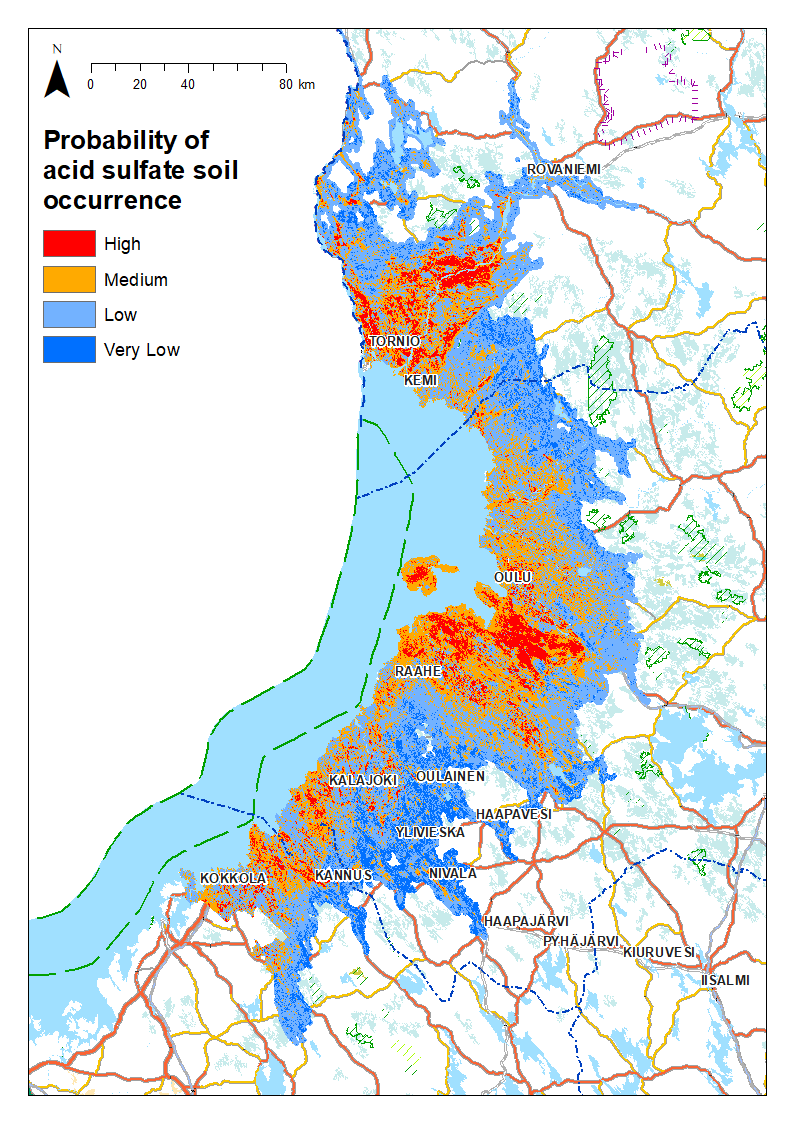HazArctic –project has approached environmental problems and risks of geo-bio hazards in the Arctic Region. It has focused on hazards which all have more or less to do with acidification of soil and water. Field work and analyses of samples has been the central working methods.
In the plan of the project, three categories of geo-biohazards were presented:
- Acid sulfate soils
- Mine environment issues
- Geomicrobiology
Acid sulfate soils

Map of the Finnish part of acid sulfate soil survey, Source: https://www.isric.org/news/isric-supports-geological-surveys-norway-sweden-and-finland-map-acid-sulfate-soils
Acid sulfate (AS) soils are considered to be the nastiest soils in the world. They are generally found in coastal settings globally. In Finland and Sweden, it is known that AS soils exist within the maximum extent of the preceding Littorina Sea (i.e. coastal areas), whereas knowledge of AS soils in similar settings in Norway is scarce.
One of the new findings of this project are that AS soils were found in the surroundings of Alta, Norway, and that potential AS soils were discovered in areas around Lake Inarijärvi and Utsjoki. The AS soils found at Alta are the northernmost AS soils in the world and show that these soils can develop in Arctic regions too.
In Sweden, it was shown that active AS soils are most common in areas with clay and silt situated at low altitudes and that the most active AS soil materials are underlain by potential AS soil materials. Potential AS soils are common in peat covered areas. The studies showed that several elements have mobilised from the active AS soils and several elements occur in high contents at the transition between the active and potential AS soil materials and some elements, for example manganese, are leached to the surroundings, for example lake sediments.
The project has improved the societal awareness of local people, decision-makers and other stakeholders regarding AS soil occurrence and environmental impact by communication of project results throughout the project time. Project results enable the authorities in all partner countries to do knowledge-based decisions in land use planning and to avoid a land use causing oxidation of potential AS soils, and thereby avoid negative environmental impacts of AS soils.
Mine environment issues
The aim of Work Package 2 was to increase the knowledge on how to study the present state of the art of the active or closed/abandoned mine sites, and to opt decommissioning/closure methods and process for follow up monitoring.
The COVID-19 related traveling and gathering restrictions set heavy obstacles to the implementation of the plan, as samples from Russia could not be taken and used, and the project participants had to cancel a lot of on-site gatherings. Nevertheless the consortium managed to carry out a ”plan B” and only some parts of the work packages had to be totally cancelled.
The project presented a promising exploration method for examining the ground on, for example, open pit areas, using unmanned aerial vehicles and photogrammetry. See in the video how it improves the speed and safety of exploration.
Mine slope stability
In this sub-task the material from European Space Agency’s Copernicus – programme was utilized to study the physical stability of the open pit slope and the waste facility. The Kovdor mine was chosen as a pilot location for these studies as there was a very large open pit with steep walls as well as a large area of mining waste dump and tailings dam. The results of satellite data processing showed compaction of the waste dumps that were like the company’s geotechnical reports. A slow movement of open pit wall towards inside of the pit was detected from the satellite data and this as well was notified in the geotechnical report.
Training on mine waste and water management and on mine closure and environmental inventory of closed mine waste facility
In a large workshop, the Participants were introduced how to assess, manage, and monitor the environmental impacts of closed and active mine sites and best practices in mine closure. In addition, the state-of-the-art methods for mine waste valorization were presented.
Geomicrobiology
This study has improved our understanding of the huge diversity and complexity of the microbial communities related to acid sulphate soils and the processes driven by them. Bacterial community structure was analyzed from the DNA of a total of 211 soil samples collected from Finland, Sweden and Norway in co-operation with the WP1’s studies. The studies found patterns in, and connections between, bacterial community structures, soil pH and sampling depth. For example, some bacteria classes appeared only in the deeper reduced layers. There seems to be also linkage between the bacterial community structure and Fe and S minerals in soil.
The project carried out experimental studies around oxidation, bacteria, impact of temperature, (and other things which the MA of Kolarctic CBC is not competent to present here). The topic needs further research to which the results of this project can create solid foundation.
The nucleotide data from microbiology studies was submitted to the European nucleotide archive. It is a worldwide gene bank and researchers can use the data for their own studies now and in the future.
Project: Geo-Bio Hazards in the Arctic Region (HazArctic)
Lead partner: Geological Survey of Finland, Rovaniemi
Other partners:
- Natural Resources Institute Finland, Helsinki
- Geological Survey of Sweden, Uppsala
- Geological Survey of Norway, Trondheim
- Geological Institute of the Kola Science Centre of the Russian Academy of Sciences, Apatity
- Mining Institute of the Kola Science Centre of the Russian Academy of Sciences, Apatity
Project information in KEEP database
